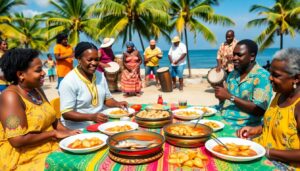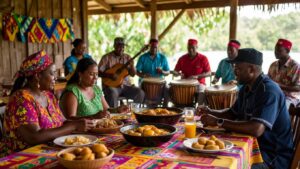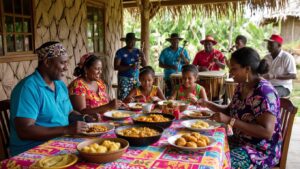Discover the Rich Tapestry of Garifuna Culture in Belize: An Immersive Exploration of Heritage, Culinary Delights, and Cultural Experiences
The Garifuna community in Belize represents a fascinating fusion of African, Indigenous Caribbean, and European influences, leading to a unique cultural legacy that is celebrated worldwide and recognised as a UNESCO Masterpiece of the Oral and Intangible Heritage of Humanity. Their vibrant traditions encompass a multitude of aspects, including a rich language, diverse music, exquisite culinary arts, lively dance forms, deep spirituality, and a profound sense of community. This detailed guide invites you to uncover the enchanting narrative of the Garifuna in Belize, delving into their history, vibrant traditions, festive celebrations, and the cultural heart of Hopkins Village.
Exploring the Depths of Garifuna Heritage and Identity
The Garifuna are among the most remarkable cultural groups in Belize, with origins that trace back to West and Central African ancestors, complemented by the Indigenous Caribs and Arawaks. Their journey commenced with a courageous struggle against colonial oppression in St. Vincent in 1797, which resulted in their forced migration to Central America. Today, approximately 30,000 Garifuna people inhabit Belize, significantly enhancing the cultural richness of southern Belize through their distinctive language, sumptuous cuisine, vibrant artistic expressions, and cherished customs. Celebrated by UNESCO for their extraordinary cultural legacy, the Garifuna's resilience, creativity, and adaptability continue to flourish in vibrant communities such as Dangriga, Hopkins, Seine Bight, and Punta Gorda, as well as throughout diaspora communities across the Americas. The annual observance of Garifuna Settlement Day on November 19 serves as a powerful reminder of their enduring narrative of strength, community spirit, and rich cultural traditions.

Delving into the Historical Foundations of the Garifuna Community
Understanding the Ancestry of African and Carib Heritage
The narrative of the Garifuna people has its origins in the 17th century, illustrating the incredible convergence of African survivors from two Spanish slave ships and the Indigenous Carib and Arawak populations of St. Vincent in the Lesser Antilles. Over a period exceeding 150 years, intermarriage and cultural interchanges birthed a unique Afro-Indigenous identity known as the Garinagu. This identity is characterised by a rich tapestry of traditions, languages, and customs that vividly encapsulate their diverse ancestral backgrounds, showcasing the remarkable beauty of their cultural heritage.
The Impact of Forced Exile and the Emergence of New Communities in Belize
In 1797, following a fierce resistance against the encroaching British colonial forces, approximately 5,000 Garifuna were forcibly displaced from St. Vincent to Roatán, Honduras. This pivotal event set in motion migrations that eventually spread along the Central American coastline. By the early 19th century, vibrant Garifuna communities had established themselves in southern Belize, particularly in culturally significant areas like Dangriga, known as the cultural capital, alongside Hopkins, Seine Bight, and Barranco. The British authorities encouraged these migrations, seeking skilled labourers proficient in fishing and agriculture, thus facilitating the development of these communities.
Upholding Resilience Amidst Adversity and Ensuring Cultural Continuity
Despite the myriad challenges wrought by European colonisation, land dispossession, and systemic discrimination, the Garifuna have successfully preserved their language, social structures, and rich religious customs. The establishment of the National Garifuna Council in 1981 has played a crucial role in advocating for cultural rights and educational initiatives, ensuring that the Garifuna heritage is widely celebrated and acknowledged.
The Significance of Language and Identity in Garifuna Culture
Understanding the Unique Characteristics of the Garifuna Language
The Garifuna language is a distinctive Arawakan tongue, notable for its incorporation of Carib and African loanwords, making it a fascinating example among Central American languages. It features gendered pronouns, a complex tense system, and a wealth of oral traditions that encapsulate the community's history and cultural values. However, the survival of the Garifuna language faces significant threats due to a language shift driven by migration and urbanisation, with fewer than 15,000 Belizean Garifuna individuals remaining fully fluent. This situation highlights the urgent need for revitalisation efforts to preserve this invaluable aspect of their cultural identity.
Initiatives for Reviving and Safeguarding Linguistic Heritage
The recognition of the Garifuna language and music as an Intangible Heritage by UNESCO in 2001 has ignited revitalisation initiatives throughout the community. In areas such as Hopkins and Dangriga, primary schools have begun implementing educational programmes in Garifuna, while local radio stations broadcast music and news in the language, promoting its ongoing use. Organisations like GAMAE International have instituted language immersion summer camps designed to reconnect youth with their ancestral roots and linguistic heritage, ensuring that the transmission of culture continues across generations.
Expressions of Identity and Connections within the Global Diaspora
The Garifuna identity is reinforced through traditional attire, ancestral lineages, clan totems, and distinctive naming practices. This identity is actively nurtured by cultural associations both within Belize and in diaspora communities in major cities such as New York, Los Angeles, and London, where they persist in celebrating their rich heritage and cultural legacy.
The Vibrant World of Garifuna Music and Dance
The Spiritual Significance of Rhythmic Drumming
Garifuna music is celebrated for its intricate rhythmic patterns, which harmoniously blend traditional African polyrhythms with indigenous chants. Central to numerous spiritual rituals and festive occasions, the drums—particularly the primero (tenor) and segunda (bass)—are of paramount importance. The sacred dugú ceremony, for example, incorporates drum circles and invocations to ancestors aimed at healing or blessing families, illustrating the profound connection between music and spirituality that permeates Garifuna culture.
The Energetic Dance Styles of Punta and Punta Rock
Among the most revered Garifuna dance forms is the punta, characterised by rapid hip movements and intricate footwork, often accompanied by call-and-response singing and vibrant percussion. The contemporary evolution of this dance style, termed punta rock, has been popularised by renowned musicians such as Andy Palacio and Pen Cayetano, who fuse traditional rhythms with modern instrumentation, thereby helping to spread Garifuna culture to audiences around the world.
Cultural Festivals and Community Engagement in Garifuna Society
In the bustling towns of Hopkins and Dangriga, dance troupes frequently perform during cultural festivals and for visiting tourists, creating a lively connection between generations. These performances not only celebrate Garifuna heritage but also serve as a crucial economic resource for the community, promoting tourism and cultural exchange while enriching the local economy.

Investigating Garifuna Cultural Practices and Spiritual Beliefs
The Significance of the Dugú Ceremony in Garifuna Tradition
The dugú ceremony is a multi-day event wherein extended families convene to honour the spirits of their ancestors, known as gubida. Led by a spiritual healer, or buyei, the ceremony includes music, dance, and communal feasting, all aimed at restoring harmony within families and the broader community. It underscores a profound respect for the land, ancestral heritage, and shared responsibilities within the community.
Daily Life and Spiritual Practices of the Garifuna People
The spiritual beliefs of the Garifuna represent a unique blend of Catholicism along with elements from African and Arawak cosmologies. Their daily lives are interspersed with various rituals, including blessings for new structures, rites of passage for births and deaths, and agricultural celebrations. Significant symbols, such as the conch shell, sea turtle, and cassava, serve as vital connections between households, the natural environment, and ancestral spirits, weaving a rich tapestry of meaning into their everyday existence.
Sampling the Culinary Delights of Garifuna Cuisine
Signature Dishes and Culinary Staples of Garifuna Gastronomy
The culinary artistry of Garifuna culture is rooted in staples such as cassava (also known as yuca), plantains, coconut, and an array of fresh seafood. Among their traditional dishes, ereba stands out as a cassava bread made from grated cassava, which is pressed and toasted over an open flame. Another hallmark dish, hudut, features fish simmered in creamy coconut milk and served alongside mashed green and ripe plantains. Machuca, a hearty fish soup with garlicky, mashed plantain dumplings, and tapou, a savoury seafood stew in coconut milk, are also cherished culinary offerings. In vibrant street markets in Hopkins and Dangriga, visitors are encouraged to indulge in local treats such as cassava pone (a sweet cake), fried plantain balls (known as ganún), and refreshing conch ceviche.
Advocating for Sustainable Culinary Practices in Garifuna Communities
Traditional Garifuna culinary methods, such as seasonal fishing, shellfish harvesting, and small-scale gardening, promote ecological stewardship and sustainability. These practices are guided by cultural taboos and principles of communal resource management, reflecting their deep connection to the environment. Culinary festivals held in Hopkins feature cooking contests and food tours arranged by women’s cooperatives, ensuring the preservation of cherished recipes and culinary techniques while engaging visitors in the rich gastronomic heritage of the Garifuna.
Hopkins Village: The Vibrant Heart of Garifuna Culture
Understanding the Historical Context and Cultural Significance of Hopkins
Founded in the early 1800s and known as Yarumein in Garifuna, Hopkins is located along the breathtaking Stann Creek coast. It serves as an essential hub for the Garifuna language, music, and crafts, embodying the rich cultural legacy of the community and functioning as a beacon for cultural preservation.
Essential Experiences to Explore in Hopkins Village
- Drum Circles: Participate in daily drum schools and enjoy nightly drum circles at local cultural centres.
- Garifuna Museum: Uncover artefacts, oral histories, and photographic archives that delve into their migration, language, and music.
- Homestays and Workshops: Engage with local families offering cooking lessons, fishing trips, and demonstrations of cassava bread preparation.
Annual cultural events in Hopkins, particularly the youth pageants during Garifuna Settlement Day, position the village as an authentic gateway to experiencing the intricate cultural tapestry of Garifuna Belize.
The Economic Impact of Cultural Tourism on the Garifuna Community
Cultural tourism plays a vital role in Hopkins, supporting over 75% of local households through guest accommodations, handicrafts, music classes, and guided tours. The headquarters of the National Garifuna Council orchestrates regional festivals and advocacy initiatives, ensuring that Garifuna culture remains vibrant and visible on the global stage.
Celebrating Garifuna Settlement Day: A Major Cultural Event
The Historical Significance of Garifuna Settlement Day
Celebrated annually on November 19 since 1941 and nationally recognised since 1977, Garifuna Settlement Day commemorates the historic arrival of Garifuna ancestors in Belize by canoe in 1802. The reenactment procession known as Yurumein depicts villagers arriving ashore, carrying drums, cassava, and crops, accompanied by joyous songs and prayers, symbolising their enduring legacy and connection to their roots.
Modern Celebrations and Festivities Surrounding Settlement Day
The festivities of Garifuna Settlement Day beautifully intertwine sacred and secular elements, featuring nightlong dugú ceremonies and all-day drumming in churches and community squares. Processions adorned in traditional attire, lively parades, dance performances, and food fairs enhance the day’s significance. National broadcasts, media features, and diaspora celebrations in major US cities attract visitors from across Belize and beyond, fostering awareness and appreciation for Garifuna cultural traditions.
Addressing Modern Challenges and Sustaining Cultural Heritage
The Critical Issue of Language Shift Among Young Garifuna
The phenomenon of language shift poses a significant challenge for the Garifuna community, as many young people, particularly in urban areas, increasingly favour English or Kriol at home. In recognition of this concerning trend, UNESCO has called for schools and NGOs to implement language immersion programmes, radio broadcasts, and mentorship initiatives aimed at preserving linguistic heritage and cultural identity, thereby ensuring the survival of the Garifuna language.
Land Rights and Tourism Development Challenges Facing the Garifuna
The rapid expansion of tourism and real estate development in coastal regions such as Seine Bight and Hopkins poses a threat to the traditional landholdings of the Garifuna. Advocacy efforts spearheaded by the National Garifuna Council, in collaboration with NGOs, focus on securing land rights, influencing urban planning, and ensuring that tourism revenues are shared equitably among local families and communities, thereby protecting their cultural heritage.
Engaging Youth Through the Arts, Technology, and Diaspora Connections
Garifuna artists and musicians, both locally and in the diaspora, actively record music, document recipes, and preserve oral histories to create digital archives and virtual festivals. These innovative platforms are crucial for fostering connections between the broader Garifuna community and younger generations, ensuring that their rich cultural heritage is upheld and celebrated.
Guidelines for Responsible Engagement with Garifuna Culture
- Choose accommodations in Hopkins, Dangriga, or Seine Bight, and arrange tours directly with Garifuna-owned businesses to support the local economy.
- Engage in a drum workshop, attend a Settlement Day celebration, or volunteer in local cultural preservation initiatives to immerse yourself in the rich cultural tapestry.
- Support women’s cooperatives by sampling traditional dishes or purchasing handcrafted items to promote sustainable livelihoods and empower the community economically.
- Always show respect for local customs; seek permission before photographing individuals, and be considerate during rituals and ceremonies.
- Learn a few basic phrases in the Garifuna language to demonstrate your respect and genuine interest in the culture.
Garifuna culture in Belize embodies a vibrant tapestry of resilience, profound spirituality, infectious music, delectable culinary offerings, and strong community ties. By visiting places like Hopkins or Dangriga, participating in local festivals, or immersing oneself in the rhythmic heartbeat of the drums, travellers are granted a unique opportunity to engage with a rich historical continuum where the past and present resonate harmoniously. Supporting Garifuna-owned businesses, honouring their traditions, and celebrating the linguistic and culinary diversity of this remarkable culture are essential steps to ensure its survival and flourishing for future generations.
References and Further Reading for Cultural Enthusiasts
- Language, Dance and Music of the Garifuna – UNESCO Intangible Heritage
- History Of The Garifuna People – Belize.com
- Garifuna people – Wikipedia
- Varner, G.R. “Native Status and Maya Identity in Belize.” Journal of Latin American Anthropology, 1998
- Lee, N.R. “Toledo Garifuna and Indigenous Rights.” Mesoamerican Research, 2022
- National Garifuna Council – Wikipedia
- The Garifuna Living Heritage – ICH NGO Forum, 2023
- Dinther, R. “Language Shift and Prestige: Garifuna in Hopkins.” Journal of Pidgin and Creole Languages, 2017
- Habinaha Garifuna Language Program
- Veal, T. “Africanisms in Garifuna Culture of Belize.” Cultural Anthropology, 2004
- National Geographic: Preserving Garifuna Identity Through Ritual
- Music In Africa: Punta Rock and Garifuna Music
- Hopkins Cultural Center Official Site
- Cultural Survival Quarterly: Maya Rainforest and Garifuna in Belize
- Belize Living Heritage: Rituals and Social Practices
- Texas A&M: Belizean Food Culture
- Love Your Belize: Hudut Recipe
- Global M&A Pages: Sustainable Fishing Cooperatives
- National Garifuna Council of Belize
- UN Sustainable Development Reports on Garifuna Cultural Tourism
- Ambergris Caye: Garifuna Settlement Day Celebrations
- Garifuna.com: Diaspora, Digital Storytelling, and Modern Initiatives
The Article Garifuna Culture in Belize: Heritage, Food & Where to Experience It appeared first on Belize Travel Guide
The Article Garifuna Culture: Experience Heritage and Cuisine in Belize Was Found On https://limitsofstrategy.com
The Article Garifuna Culture: Discover Belize’s Heritage and Cuisine found first on https://electroquench.com

